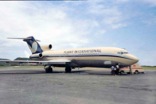What was once the best airline industry in the world became a shadow of past glory. Many of the companies that pioneered air transportation–PanAm, National, Eastern, Braniff, Western and later, TWA and Continental–disappeared forever. For me, what had been the best job in the world, deteriorated to a point where I hated going to work. In 1983, after fifteen years of service with a once proud airline, I found myself on the street facing a very uncertain future.
Every pilot who survived this era has their own story. Many simply walked away from flying and transitioned into more stable careers. That decision was not difficult for me. All I wanted to do was fly airplanes and I was not going to let misfortune drive me out of my chosen profession. Fortunately I didn't have a family to support and was reasonably debt free. Also in my favor was the fact that I had a lot of experience in the Boeing 727, a commodity which almost guaranteed employment with one of the new airlines that were springing up like weeds. Over the next nineteen years, I wore the uniform of five different airlines–each one better than the one before. It was a wild ride!
I found the adage "it is easier to find a job if you already have one" to be very true. I was never unemployed for more than a few days at a time; and although the pay and working conditions were not always so good, I was doing what I wanted to do. Looking back, I wouldn’t change many of the decisions I made. I had a good career which spanned 34 years. I flew airplanes I enjoyed flying and flew to some of the most interesting places in the world–while working with some of the finest people I could ever have chosen to associate with.
Below are some of the airplanes in which I spent many enjoyable hours–and a few that weren't so enjoyable. They all hold fond memories.
Click a thumbnail for a larger image



















“Old pilots never die, the airplanes just pass them by.”
Gill Rob Wilson – 1892-1966 – American pilot, Presbyterian minister, early editor of Flying Magazine